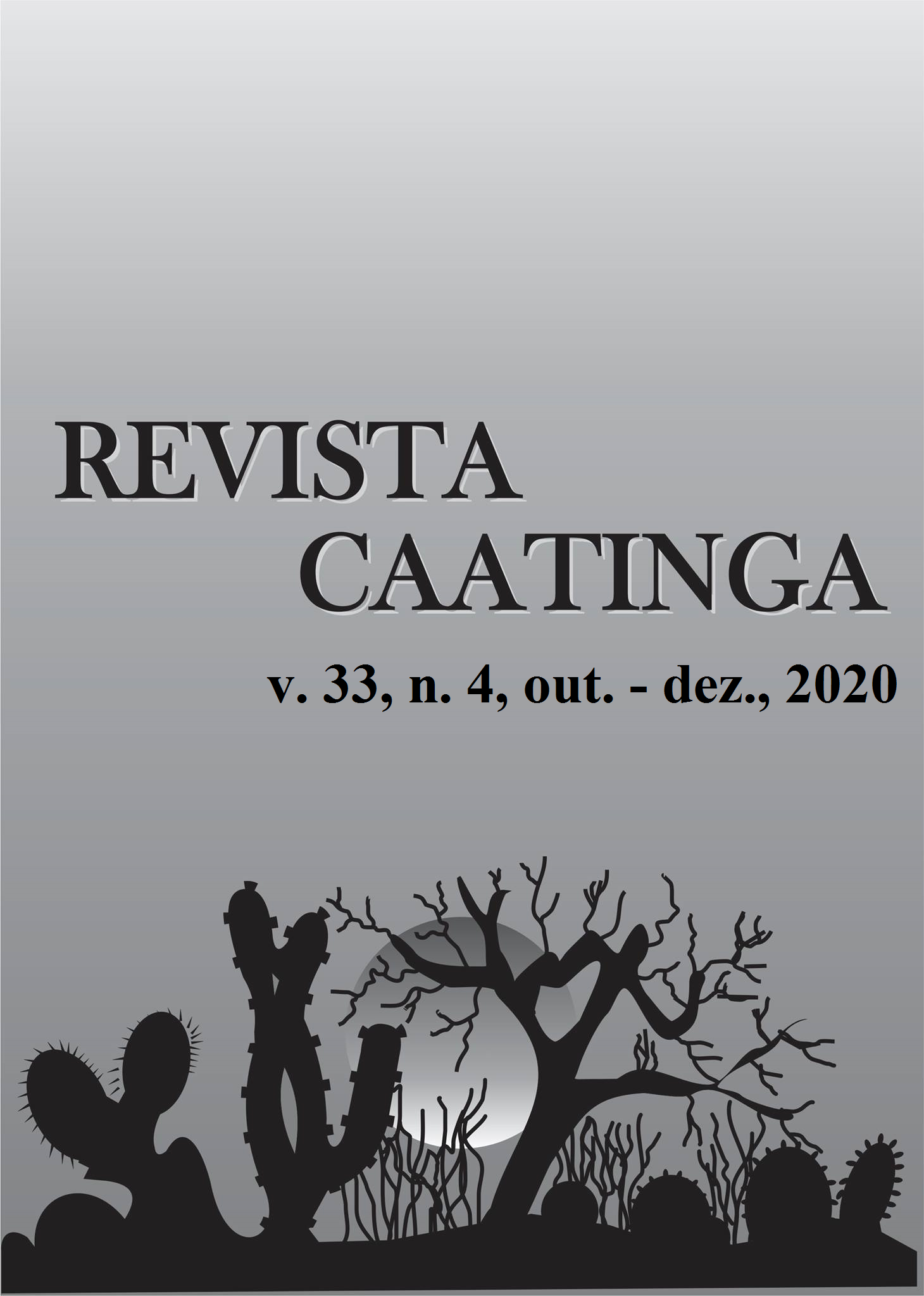COMBINING ABILITY OF GRAIN SORGHUM INBRED LINES GROWN DURING OFF-SEASON
DOI:
https://doi.org/10.1590/1983-21252020v33n403rcKeywords:
Sorghum bicolor. Diallel crosses. Parent selection. Plant breeding.Abstract
The expansion of sorghum as a succession crop, after soybean, has demanded the development of new inbred lines by the breeding programs. The first step in the selection process consists of evaluating the performance per se of the inbred lines or of their hybrid combination. The purpose of this study was to determine the combining ability of sorghum inbred lines under different environment conditions of the crop production areas. The trials were carried out in the second season of 2017, under no-tillage system, in four environments, Rio Verde, Sete Lagoas, Teresina and Sinop. Thirty hybrids, resulting from the crosses of six fertility restoration lines (R) with five male-sterile lines (A) were evaluated. A randomized complete block design with three replicates was used in all experiments. The characteristics evaluated were flowering, plant height and grain yield. The environment significantly influenced the estimates of general and specific combining ability, which suggests that both effects, additive and dominant, are important in the control of these characters. The restoring lines GI.1 and G1.2 contributed to increasing the grain yield of their hybrids by over 650 kg.ha-1. Among the male-sterile lines, the best for grain yield were GII.1 and GII.4 with contribution above 450 kg.ha-1 in the hybrids in which they participate. The hybrid combinations GI.5xGII.3 and GI.1xGII.2 stood out with potential to obtain high grain yield, associating positive aspects of the other characteristics.
Downloads
References
ALMEIDA FILHO, J. E. et al. Desempenho agronômico e estabilidade fenotípica de híbridos de sorgo granífero. Revista Brasileira de Milho e Sorgo, 9: 51-64, 2010.
BANZATTO, D. A.; KRONKA, S. N. Experimentação Agrícola. 4. ed. Jaboticabal, SP: FUNEP, 2006. 237 p.
BATISTA, P. S. C. et al. Selection of sorghum for drought tolerance in a semiarid environment. Genetics and Molecular Research, 18: 01-11, 2019.
COMPANHIA NACIONAL DE ABASTECIMENTO - CONAB. Acompanhamento da Safra Brasileira de Grãos: 11º levantamento, safra 2018/19. v. 6, n. 11. Brasília, DF: Conab, 2019.
CRUZ, C. D.; CARNEIRO, P. C. S.; REGAZZI, A. J. Modelos biométricos aplicados ao melhoramento genético. 3. ed. rev. e ampl. Viçosa, MG: UFV, 2014. 668 p.
EMPRESA BRASILEIRA DE PESQUISA AGROPECUÁRIA - EMBRAPA. Sistema Brasileiro de Classificação de Solos. 3. ed. Rio de Janeiro, RJ: EMBRAPA, 2013. 353 p.
GRIFFING, B. Concept of general and specific combining ability in relation to diallel crossing systems. Australian Journal of Biological Sciences, 9: 463-493, 1956.
KENGA, R.; ALABI, S. O.; GUPTA, S. C. Combining ability studies in tropical sorghum (Sorghum bicolor (L.) Moench). Field Crops Research, 88: 251-260. 2004.
KUMAR, A. A. et al. Recent advances in sorghum genetic enhancement research at ICRISAT. American Journal of Plant Sciences, 2: 589-600, 2011.
MAHDY, E. E; ALI, M. A; MAHMOUD, A. M. The effect of environment on combining ability and heterosis in grain sorghum (Sorghum bicolor L. Moench). Asian Journal of Crop Science, 3: 1-15, 2011.
MAKANDA, I. et al. Combining ability and cultivar superiority of sorghum germplasm for grain yield across tropical low- and mid-altitude environments. Field Crops Research, 116: 75-85, 2010.
MENEZES, C. B. et al. Combining ability of grain sorghum lines selected for aluminum tolerance. Crop Breeding and Applied Biotechnology, 14: 42-48, 2014.
MENEZES, C. B et al. Capacidade combinatória de linhagens e seleção de híbridos de sorgo granífero. Revista Brasileira de Milho e Sorgo, 16: 509-523, 2017.
PRAKASH, R. et al. Combining ability for fodder yield and its components in Sorghum (Sorghum bicolor L). Electronic Journal of Plant Breeding, 1: 124-128, 2010.
ROONEY, W. L. Sorghum improvement - integrating traditional and new technology to produce improved genotypes. Advances in Agronomy, 83: 37-109, 2004.
ROONEY, W. Sorghum breeding. In: ACQUAAH, G. (Ed.). Principles of plant genetics and breeding. 2. ed. Chichester: Wiley-Blackwell, 2012. cap. 34, p. 617-627.
SANTOS, F. G.; CASELA, C. R.; WAQUIL, J. M. Melhoramento de sorgo. In: BORÉM, A. (Ed.). Melhoramento de espécies cultivadas. 2. ed. Viçosa, MG: UFV, 2005. v. 1, p. 429-466.
TADESSE, T.; TESSO, T.; EJETA, G. Combining ability of introduced sorghum parental lines for major morpho-agronomic traits. SAT eJournal, 6: 1-7, 2008.
TARDIN, F. D. et al. Avaliação agronômica de híbridos de sorgo granífero cultivados sob irrigação e estresse hídrico. Revista Brasileira de Milho e Sorgo, 12: 102-117, 2013.
VENCOVSKY, R.; BARRIGA, P. Genética biométrica no fitomelhoramento. 1. ed. Ribeirão Preto, SP: SBG, 1992. 496 p.
ZANATTO, I. B. et al. Identificação de caracteres relacionados à precocidade e produtividade em híbridos de sorgo via correlações canônicas. Revista Científica Intelletto, 1: 89-94, 2016.
Downloads
Published
Issue
Section
License
Os Autores que publicam na Revista Caatinga concordam com os seguintes termos:
a) Os Autores mantêm os direitos autorais e concedem à revista o direito de primeira publicação, com o trabalho simultaneamente licenciado sob a Licença Creative Commons do tipo atribuição CC-BY, para todo o conteúdo do periódico, exceto onde estiver identificado, que permite o compartilhamento do trabalho com reconhecimento da autoria e publicação inicial nesta revista, sem fins comerciais.
b) Os Autores têm autorização para distribuição não-exclusiva da versão do trabalho publicada nesta revista (ex.: publicar em repositório institucional ou como capítulo de livro), com reconhecimento de autoria e publicação inicial nesta revista.
c) Os Autores têm permissão e são estimulados a publicar e distribuir seu trabalho online (ex.: em repositórios institucionais ou na sua página pessoal) a qualquer ponto antes ou durante o processo editorial, já que isso pode gerar alterações produtivas, bem como aumentar o impacto e a citação do trabalho publicado (Veja O Efeito do Acesso Livre).







